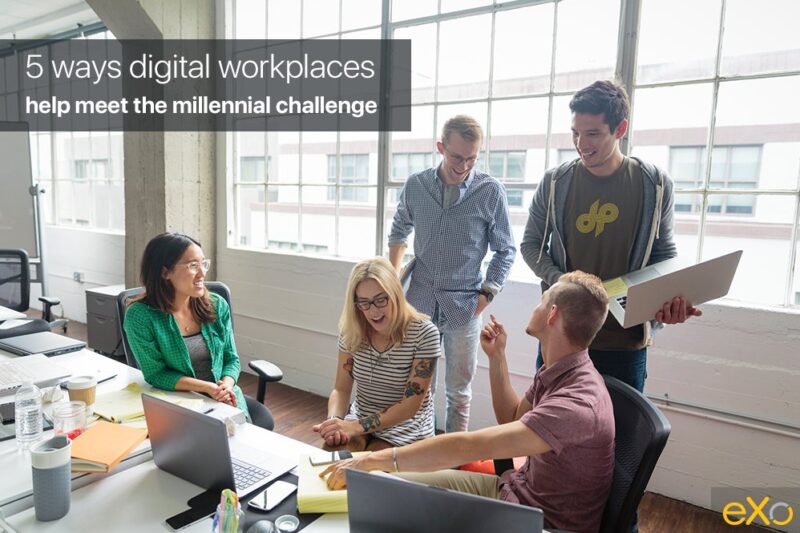- Veronika Mazour
- April 20, 2017
5 ways digital workplaces help meet the millennial challenge
The thinking behind this blog post started with this funny video on the millennial question that went viral.
On top of being really funny, it resonated with me on several points. Being from good old reliable generation X myself, I have struggled and am still struggling with learning to manage millennials efficiently – in a way that will both expand their potential and deliver the results I am looking for in a team or a mid-level manager.

Content
At the same time, I feel that millennial energy is feeding many of the positive changes we are seeing in the way we view management, work and even life in general.
I’ve been baffled a number of times by young people turning down amazing career opportunities in favour of an “I need to think about my purpose in life on an island in Brazil” approach.
And while I find it quite egotistical, in some ways I cannot help but admire this quest for personal freedom and spiritual meaning.
Who are the millennials?
Millennials (or generation Y) are people born roughly between 1980 and 2000, who entered adulthood at the turn of the century. It is not a mathematical term: there is no consensus on their exact birth dates.
Rather, the term is used to describe distinctive characteristics of a group of people when related to work, consumer habits, social connections and life values.
Of course, as with any labels, this one does not apply to every individual born in those years – even the traits commonly associated with millennials vary from one author to another. Entitlement and narcissism are among the traits frequently used to describe millennials they are sometimes even called Generation Me.
Yet, other authors focus on millennials’ sense of community and social consciousness. Meanwhile, in the above video the speaker stresses millennials’ impatience and dependence on technology.
What challenges do millennials pose for managers?
Finally, millennials engage strongly with technology. Some authors point out that this engagement can be detrimental to forming healthy relationships in the workplace or outside.
Yet, others state that social media use has helped to develop collaborative skills, and that millennials have a preference for a team-oriented environment.
In any case, millennials strongly associate job satisfaction with flexibility, connectivity to managers and peers, and the free flow of information.
From the manager’s point of view, these characteristics of millennials translate into too high expectations in the workplace and from their managers.
Failure to provide what they expect usually leads to millennials quitting for greener pastures.
Are millennials broken?
A number of psychologists and management gurus underline that millennials’ issues are the result of inadequate parenting, abusive use of technology and so forth.
In a nutshell, a lot of management advice focus on ways to onboard millennials into the corporate culture and working environment as is: helping them go without all the technology they want, helping them to accept the idea of sacrificing the present for the future, helping them to form “real” relationships, and so on.
In fact, the same philosophy drives a lot of new parenting advice today, particularly in Silicon Valley. Limited screen time, home schooling, home-made wooden toys – these are all attempts at “correcting” the education that millennials have received, essentially trying to replace it with the type of education we received before technology exploded.
I cannot help but wonder, though, if clinging to the “old way”, be it in the workplace or in the education of our generation Z kids, is the way to go.
After all, did our parents not also find our education to be lacking? Perhaps the best way to manage millennials is to adapt to them and not the other way around?
How can digital workplaces help to address the millennial challenge?
I see digital workplaces as workplaces for millennials. These workplaces challenge the way traditional corporations are structured and operate, inviting, and sometimes forcing, deep organizational transformations.
Here are 5 ways in which digital workplaces can help to provide environments for millennials to thrive in:
Technology
The technology behind a digital workplace naturally extends the physical work environment and adds a virtual plane to it.Connections can occur between people in the physical office, but also virtually, with people in a wider network.
Collaboration can happen between people who are many miles away from each other. Connectivity between people, information and the organization’s knowledge resources is immediate and thorough.
Immediate feedback
Digital workplaces imply more visibility on everything that is happening and thus, more immediate feedback. This feedback can appear on a familiar social activity stream, effortlessly and daily.
The manager can praise or comment, and peers can also express approval, thus encouraging everyone’s effort and input.
Work-life balance
Digital workplaces go with flexibility and an improved work-life balance. Why? Because they allow people to work remotely without loss of productivity, connectivity or social interaction.
Those who would otherwise have to commute from far can work from their homes. Some can even go to that Brazilian island and still continue with their career paths. (I do admit that this model does not work for all jobs; the point is that none of it would be possible at all without digital workplaces).
Meaning
Digital workplaces help find the elusive meaning that millennials seek. Instead of formal top-down communication, digital workplaces facilitate free information flow and two-way communication.
As a result, coworkers are automatically informed about what other people are doing and why, and can form more meaningful connections and increase their sense of alignment and belonging.
Flat corporate structure
The millennials’ preference for flat corporate structures appears incompatible with the way most organizations are structured today, using traditional hierarchies.
Even though a lot has been written and said on the benefits of flattening the hierarchies, such huge changes do not happen overnight even in an organization that inspires to this goal.
However, digital workplaces can help flatten an organisation to some extent in practice. In a digital workplace, people with different functions in the organization can create ad hoc collaboration projects or initiatives without questioning their respective hierarchical groups.
Such flexibility not only opens doors to innovation, but also answers millennials’ need for a flatter structure.
When we started using eXo as our digital workspace, it gained adoption with our youngest teams first, providing me with a great way to manage them from a distance.
If it did not solve all issues, it did help tremendously in avoiding the need for daily encouragement calls and elevator pitches.
If you want to contribute to this discussion, do not hesitate to leave a comment, especially if you have other useful tips.

FREE WHITE PAPER
Types of Digital workplace solutions
The modern workplace has evolved significantly in recent years, with advancements in technology, the growing number of tools …
FAQs
You will find here Frequently Asked Questions about digital workplace with all the answers in one place.
What is a digital workplace?
A digital workplace is a next generation of intranet solutions or intranet 2.0 that is based on three pillars: communication, collaboration and information. In a way this definition is true but it doesn’t cover the whole spectrum of the term.
Here are some definitions of digital workplace:
- An evolution of the intranet
- A user centric digital experience
How to launch an effective Digital Workplace?
- Understand users’ needs
- Identify your digital workplace ambassadors
- Build the digital workplace brand
- Training and onboarding
- Plan the big day
What does digital workplace really mean?
How to be a good digital workplace manager?
- Analytical skills and approach
- Focus on employees
- Communication and strategic vision
- Tags: Digital workplace, Tips & Tricks
Related posts
- All
- eXo
- Digital workplace
- Employee engagement
- Open source
- Future of work
- Internal communication
- Collaboration
- News
- intranet
- workplace
- Knowledge management
- Employee experience
- Employee productivity
- onboarding
- Employee recognition
- Change management
- Cartoon
- Digital transformation
- Infographic
- Remote work
- Industry trends
- Product News
- Thought leadership
- Tips & Tricks
- Tutorial
- Uncategorized
Leave a Reply
( Your e-mail address will not be published)


